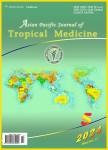Microsporidiosis in Iran:A systematic review and meta-analysis
Microsporidiosis in Iran:A systematic review and meta-analysis作者机构:Pediatric Health Research CenterTabriz University of Medical Sciences Department of Parasitology and MycologyFaculty of MedicineTabriz University of Medical Sciences Immunology Research CenterTabriz University of Medical Sciences Department of PediatricsFaculty of MedicineTabriz University of Medical Sciences Department of Statistics and EpidemiologyFaculty of Health SciencesTabriz University of Medical Sciences Research Center of Evidence Based MedicineTabriz University of Medical Sciences
出 版 物:《Asian Pacific Journal of Tropical Medicine》 (亚太热带医药杂志(英文版))
年 卷 期:2017年第10卷第4期
页 面:322-330页
核心收录:
学科分类:1002[医学-临床医学] 100201[医学-内科学(含:心血管病、血液病、呼吸系病、消化系病、内分泌与代谢病、肾病、风湿病、传染病)] 10[医学]
基 金:financially supported by Pediatric Health Research Center Tabriz University of Medical Sciences Iran
主 题:Microsporidia Microsporidiosis Genotypes Iran Prevalence Epidemiology
摘 要:Objective:To examine all evidences about Microspondia infection in vertebrate/invertebrate hosts and Iranian populations distributed in different regions of the ***:All published articles up to December 2015,including descriptive and cross-sectional studies related to the prevalence and genotyping of Microspondia infection in Iran,was considered in this systematic *** meta-analysis was done using the random-effects model and Stats Direct statistical *** 5.05 software and maximum likelihood algorithm with Kimura 2-parameter model were used for phylogenetic ***:Of the 1 152 investigated studies,33 eligible studies reported a prevalence of Microspondia infection in vertebrate and invertebrate *** to this systematic review,the overall prevalence rate of Microsporidia infection in immunocompromised patients in Iran was 8.18%.Furthermore,the overall prevalence rate of Microsporidia infection in immunocompromised patients with chronic diarrhoea,patients with non-diarrhoea,gastroenteritis,and patients with CD4( 200 cells/μL) was 15.4%,4.1%,0.5%,and 12.9%*** highest prevalence rate of human and animal Microsporidia was estimated in Kerman(29%) and Khuzestan(26.5%).The overall prevalence rate of Microsporidia infection in honeybees using the random-effects model was 40%.Furthermore,the highest prevalence rate of nosemosis was described in East Azerbaijan(48.2%).The maximum number of Microsporidia isolates from immunocompromised patients and pigeons in Iran belonged to genotypes D(n=16;50%) and E(n=6;20.6%) of Enterocytozoon ***:This study may be the first systematic review and meta-analysis that provides a broad outlook on the prevalence of microsporidiosis in *** is necessary to investigate Microsporidia infection in vertebrate and invertebrate hosts and environmental resources in Iran.



